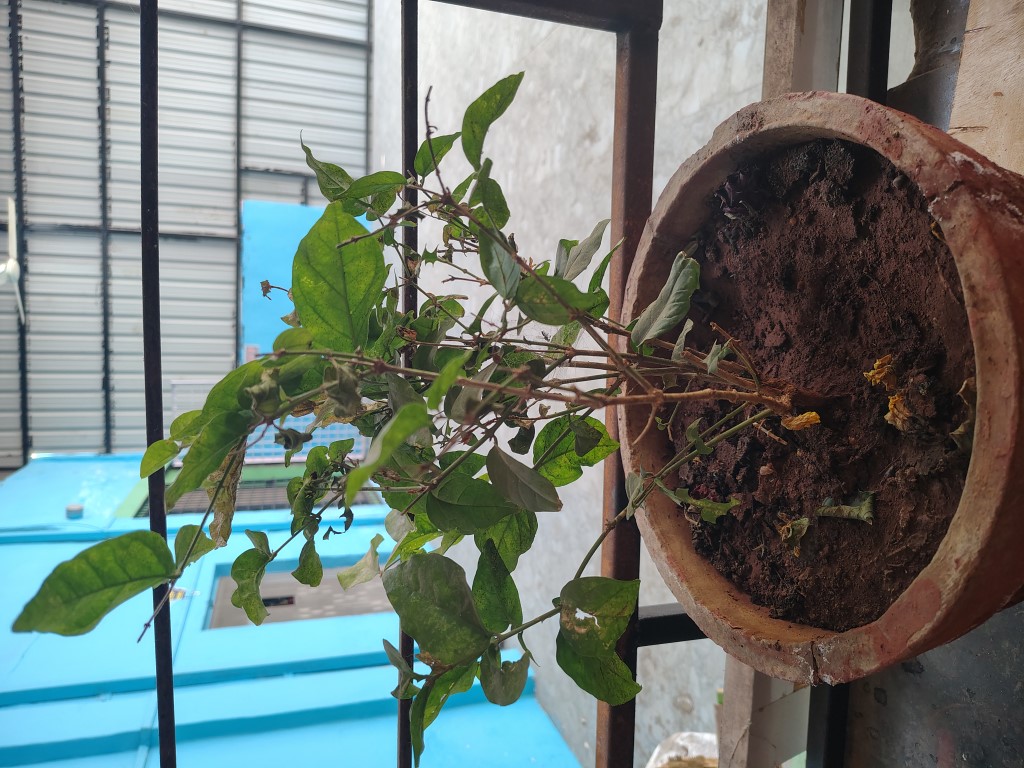Green Campus/Tree Details

मोगरा ( Jasmine )
Tree Count :
मोगरा (Mogra):
- शास्त्रीय नाव: Jasminum sambac
- कुटुंब: ओलेएसी (Oleaceae)
- उगमस्थान: दक्षिण आणि आग्नेय आशिया. उष्णकटिबंधीय आणि उपोष्णकटिबंधीय भागांमध्ये मोठ्या प्रमाणावर लागवड केली जाते.
वैशिष्ट्ये:
- फुले: लहान, शुभ्र आणि सुवासिक फुले. पूजा, हार, आणि अत्तरासाठी याचा वापर होतो.
- पाने: गर्द हिरवी, गुळगुळीत आणि अंडाकृती आकाराची असतात.
- वाढ: चांगल्या निचऱ्याच्या मातीमध्ये चांगली वाढ होते. भरपूर सूर्यप्रकाश किंवा अर्धसावलीत जोमाने वाढते.
- आकार: झुडूप स्वरूपात किंवा वेलीप्रमाणे वाढणारे झाड. कापणी करून आकार राखता येतो.
उपयोग:
- धार्मिक आणि सांस्कृतिक: फुले मंदिरे, पूजा आणि धार्मिक कार्यक्रमांसाठी वापरली जातात.
- सुवासिक उपयोग: मोगऱ्याच्या फुलांचा सुगंध अत्तर, सुगंधी तेल, आणि साबणांमध्ये वापरला जातो.
- औषधी उपयोग: मोगऱ्याचा चहा तणाव कमी करण्यासाठी आणि मानसिक शांततेसाठी उपयोगी आहे.
झाडाची काळजी कशी घ्याल?
- पाणी: नियमितपणे पाणी द्या. मात्र, माती ओलसर असावी; पाणी साठू नये.
- सूर्यप्रकाश: भरपूर सूर्यप्रकाश आवश्यक आहे; थोड्या अर्धसावलीत देखील टिकते.
- खत: दर 2-3 महिन्यांनी सेंद्रिय खत (कंपोस्ट) वापरा, यामुळे चांगली फुलं येतात.
- छाटणी: झाडाच्या चांगल्या वाढीसाठी आणि फुले यावीत म्हणून वेळोवेळी छाटणी करा.
जर हे मोगऱ्याचे झाड नसेल, तर कृपया फुलांचा रंग, झाडाचा सुगंध किंवा इतर वैशिष्ट्ये कळवा, जेणेकरून अधिक अचूक ओळख सांगता येईल!
Characteristics:
- Flowers: Produces small, white, fragrant flowers, often used in garlands, religious rituals, and perfumes.
- Leaves: Bright green, oval-shaped, and smooth in texture.
- Growth: Thrives in well-drained soil and prefers sunny to partially shaded locations.
- Size: Can grow as a small shrub or vine, depending on the variety and pruning.
Cultural and Religious Significance
Jasmine is deeply rooted in Indian culture and is often associated with purity, love, and spirituality. Its flowers are commonly offered in temples and used in Hindu religious rituals. Garlands made from Jasmine are used during festivals, weddings, and traditional ceremonies.
Uses of Jasmine
- Aromatic: Jasmine flowers are prized for their sweet scent, which is used in perfumes, essential oils, and incense. The plant’s oil is a key ingredient in many luxury fragrances.
- Ornamental: With its glossy green leaves and fragrant white flowers, Jasmine is a beautiful addition to home gardens, balconies, and patios.
- Medicinal: Jasmine has several therapeutic properties:
- Jasmine tea is popular for its calming and stress-relieving effects.
- The essential oil is believed to have antiseptic, anti-inflammatory, and aphrodisiac properties.
- Skincare: Jasmine oil is used in beauty products for its moisturizing and soothing properties.
How to Care for Jasmine?
- Sunlight: Jasmine thrives in bright sunlight. At least 4-6 hours of direct sunlight daily is ideal. It can tolerate partial shade but may not flower as abundantly.
- Watering: Keep the soil moist but well-drained. Avoid overwatering as it can cause root rot. During summer, the plant may require more frequent watering.
- Soil: Jasmine prefers slightly acidic, nutrient-rich, and well-drained soil. Adding organic compost improves soil quality and encourages flowering.
- Fertilizer: Use organic compost or a balanced fertilizer (rich in phosphorus and potassium) every 6-8 weeks to promote healthy growth and flowering.
- Pruning: Regular pruning helps maintain the plant's shape and encourages new growth. Remove dead or dry branches to allow the plant to focus its energy on producing flowers.
Varieties of Jasmine
There are numerous Jasmine varieties, but the most popular ones include:
- Jasminum sambac (Arabian Jasmine): Known for its large, fragrant flowers.
- Jasminum officinale (Common Jasmine): A climbing variety with fragrant white blooms.
- Jasminum grandiflorum (Royal Jasmine): Widely cultivated for its essential oil.
Pest and Disease Management
While Jasmine is relatively hardy, it can sometimes be affected by pests like aphids, spider mites, and whiteflies. These can be managed using neem oil or insecticidal soap. Fungal diseases, like root rot or powdery mildew, can occur in poorly drained soil or overly humid conditions.
Conclusion
Jasmine is a versatile and rewarding plant that adds beauty and fragrance to any space. Its cultural significance, aromatic qualities, and medicinal uses make it a valuable addition to gardens and homes. With proper care, it blooms profusely, filling the air with its delightful fragrance.
